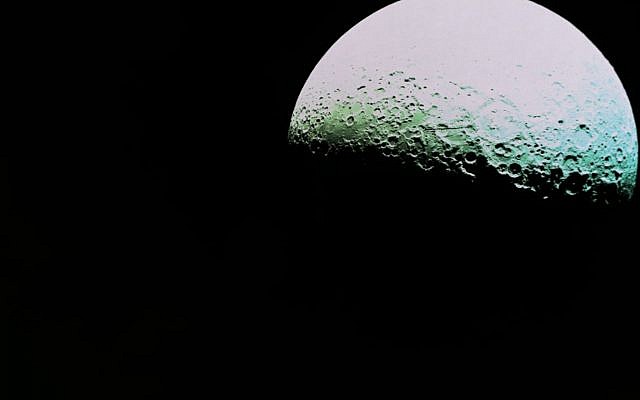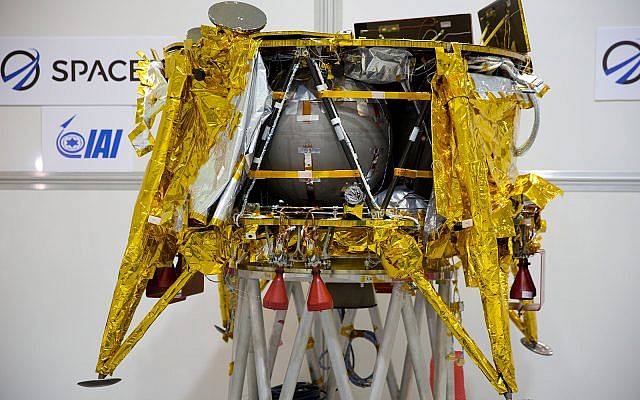
Israelis reach for the moon tonight. Here’s how to watch
If Beresheet lands successfully on Thursday night, Israel will become just the 4th country to put a spacecraft on the moon.
After 47 days and 6.5 million kilometers, the Beresheet journey is set to draw to a close on Thursday night as the four-legged spacecraft aims to land on the moon’s surface at 10:25 p.m. (Israel time). If successful, it will make Israel the fourth country to land a spacecraft on the moon.
Advertisement
Engineers activated Beresheet’s engines on Wednesday night for the final maneuver, putting the spacecraft into its smallest elliptical orbit around the moon, which meant it completed a full circuit in just two hours. At its closest point, the spacecraft is 15 to 17 kilometers (9.3-10.6 miles) above the moon’s surface.
If all goes to plan, the spacecraft will gently set down on the Sea of Serenity, and spend two to three days carrying out science experiments studying the moon’s magnetic field before the sun’s rays will become too strong and disable the spacecraft’s computers.
Dozens of places around the country are hosting parties to watch the lunar landing, including Beit Hanasi in Jerusalem, where President Reuven Rivlin will host dozens of children, and the Jerusalem Cinematheque.
The David InterContinental Hotel in Tel Aviv is hosting a “landing party” with thousands of people expected to watch the landing on big screens and then do their own moonwalk with resident DJs.
Viewe rs can also follow along at home on the Beresheet English Facebook page or YouTube channel.
rs can also follow along at home on the Beresheet English Facebook page or YouTube channel.
Last week, Beresheet’s engineers executed the most complicated maneuver yet, a perfectly choreographed space hop allowing the car-sized spacecraft to jump from an orbit around Earth to one around the moon — making Israel the seventh country in the world to achieve the feat.
SpaceIL CEO Ido Anteby said last week that almost all of the spacecraft’s systems operated successfully. There were a few minor hiccups, including an issue with the star tracker, which was blinded by reflections from the sun and made it difficult for engineers to orient the spacecraft at certain angles. Engineers were able to overcome this issue by checking the spacecraft’s orientation during times when the sun’s reflection did not overpower the sensors, which required more complicated maneuvers than originally planned. Engineers are continuing to study the problem to understand how it can be avoided in the future, said Anteby.
The spacecraft also dealt with a number of unexpected system resets, similar to when a smartphone shuts down for no reason. One of these resets delayed the second maneuver to bring the spacecraft to a larger elliptical orbit around the Earth. Engineers were able to remotely send a number of system updates to the spacecraft while in flight in order to fix problems that came up along the way.
In total, the spacecraft has traveled about 6.5 million kilometers (4 million miles). This is the slowest and longest trip a spacecraft has ever made to the moon. The distance from the Earth to the moon is an average about 385,000 kilometers (239,000 miles).
For landing, engineers looked for a flat spot on the moon that is about 30 kilometers in diameter, and need to time the landing to make sure the sun hasn’t started warming the surface. When the sun is directly on the moon, temperatures on the surface can rise to 150 degrees Celsius (302 degrees Fahrenheit), said Anteby.
First, engineers will bring the spacecraft to a height of about 25 kilometers above the moon’s surface, at which point the spacecraft’s sensors will take over automatically, with its engines pointing down so that activating the engines will act as a braking device, slowing the spacecraft from 6,000 kph to 0 kph. The landing gear utilizes lasers to help the spacecraft brake correctly until it reaches a height of 5 meters (16 feet), when the engines will shut off and the spacecraft will hopefully fall to the moon’s surface. Because the moon’s gravity is about a sixth of Earth’s gravity, it is the equivalent of the spacecraft traveling about 80 centimeters in freefall on Earth.
Beresheet will land blindly on the moon, and stray boulders or craters pose a significant risk that could cause the spacecraft to topple over upon landing, said Anteby. The entire landing process will take about 25 minutes, during which time the spacecraft will be operating automatically and engineers will not be able to correct or change the spacecraft’s movement.
By utilizing the gravitational pull of the earth and the moon and only activating the engines at the nearest and farthest points on the ellipses, engineers were able to drastically reduce the amount of fuel needed for the spacecraft’s journey. Fuel still accounts for the majority of Beresheet’s weight. At launch, the spacecraft weighed a total of 600 kilograms (1,300 pounds), of which about 440 kilograms (970 pounds) were fuel.
Beresheet, which means “Genesis” in Hebrew, lifted off on February 22 from Cape Canaveral in Florida atop a Falcon 9 rocket from the private US-based SpaceX company of entrepreneur Elon Musk.
Last month, Beresheet sent back a photo taken with its “selfie camera,” in which the Israeli flag can be seen 37,600 kilometers (23,000 miles) above Earth.
The project launched as Israel’s entry into the Google LunarX challenge for nongovernmental groups to land a spacecraft on the moon. Google ended the contest in 2018 with no winners, but the Israeli team decided to continue its efforts privately.
With Beresheet, Israel hopes to become the fourth country in the world to land a spacecraft on the moon, following the US, Russia, and China.
If successful, Beresheet will make history twice: as the first private-sector landing on the moon, and the first craft from Israel to reach the orb.
If Beresheet successfully lands on April 11, the spacecraft is expected to carry out two or three days of experiments collecting data about the moon’s magnetic fields before shutting down. There it will stay, possibly for eternity, on the moon’s surface, joining approximately 181,000 kilograms (400,000 pounds at Earth weight) of manmade debris strewn across the moon’s surface.
Credit: The Times of Israel



